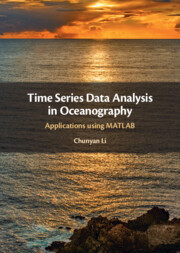Book contents
- Time Series Data Analysis in Oceanography
- Time Series Data Analysis in Oceanography
- Copyright page
- Contents
- Preface
- Acknowledgments
- 1 Introduction
- 2 Introduction to MATLAB
- 3 Time and MATLAB Functions for Time
- 4 Deterministic and Random Functions
- 5 Error and Variability Propagation
- 6 Taylor Series Expansion and Application in Error Estimate
- 7 Spherical Trigonometry and Distance Computation
- 8 A System of Linear Equations and Least Squares Method
- 9 Base Functions and Linear Independence
- 10 Generic Least Squares Method and Orthogonal Functions
- 11 Harmonic Analysis of Tide
- 12 Fourier Series
- 13 Fourier Transform
- 14 Discrete Fourier Transform and Fast Fourier Transform
- 15 Properties of Fourier Transform
- 16 More Discussion on the Harmonic Analysis and Fourier Analysis
- 17 Effect of Finite Sampling
- 18 Power Spectrum, Cospectrum, and Coherence
- 19 Window Functions for Reducing Side Lobes
- 20 Convolution, Filtering with the Window Method
- 21 Digital Filters
- 22 Rotary Spectrum Analysis
- 23 Short-Time Fourier Transform and Introduction to Wavelet Analysis
- 24 Empirical Orthogonal Function Analysis
- References
- Index
19 - Window Functions for Reducing Side Lobes
Published online by Cambridge University Press: 21 April 2022
- Time Series Data Analysis in Oceanography
- Time Series Data Analysis in Oceanography
- Copyright page
- Contents
- Preface
- Acknowledgments
- 1 Introduction
- 2 Introduction to MATLAB
- 3 Time and MATLAB Functions for Time
- 4 Deterministic and Random Functions
- 5 Error and Variability Propagation
- 6 Taylor Series Expansion and Application in Error Estimate
- 7 Spherical Trigonometry and Distance Computation
- 8 A System of Linear Equations and Least Squares Method
- 9 Base Functions and Linear Independence
- 10 Generic Least Squares Method and Orthogonal Functions
- 11 Harmonic Analysis of Tide
- 12 Fourier Series
- 13 Fourier Transform
- 14 Discrete Fourier Transform and Fast Fourier Transform
- 15 Properties of Fourier Transform
- 16 More Discussion on the Harmonic Analysis and Fourier Analysis
- 17 Effect of Finite Sampling
- 18 Power Spectrum, Cospectrum, and Coherence
- 19 Window Functions for Reducing Side Lobes
- 20 Convolution, Filtering with the Window Method
- 21 Digital Filters
- 22 Rotary Spectrum Analysis
- 23 Short-Time Fourier Transform and Introduction to Wavelet Analysis
- 24 Empirical Orthogonal Function Analysis
- References
- Index
Summary
We have learned that, in theory, a single frequency sinusoidal function in a time domain corresponds to an isolated line in the frequency domain. For multiple frequencies with linearly superimposed sinusoidal functions in time, the frequency domain representation is a series of lines (the so-called line spectrum). When finite sampling is performed, the isolated lines will be replaced by sinc functions centered on the locations of the lines in frequency. The lines are “smeared” to become continuous functions; each has a main lobe of finite width (), and side lobes or a series of decaying ringing toward both smaller and larger frequencies. This chapter discusses some techniques to reduce the ringing (side lobes) away from the main lobes. This is the windowing technique. This usually is done at a price: widening of the main lobe, which is sometimes acceptable in order to substantially reduce the side lobes.
Keywords
- Type
- Chapter
- Information
- Time Series Data Analysis in OceanographyApplications using MATLAB, pp. 348 - 356Publisher: Cambridge University PressPrint publication year: 2022

